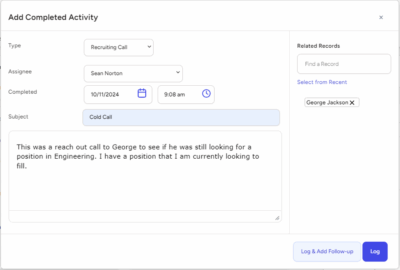(Editor’s note: The information from this article by Top Echelon Recruiting Software has been taken from an Expert Recruiter Coaching Series webinar by Bob Marshall of TBMG International titled, “The Total Account Executive: How to Find, Hire, Train, and Retain Them” Click HERE to watch the video of that training webinar for free.)
In recruiting, one of the most enduring questions leaders ask is: How do we find and develop a true big biller? The elusive “total account executive” is the recruiter who not only performs at the highest level but does so with consistency, discipline, and a deep understanding of both client and candidate psychology.
Bob Marshall of TBMG International—an industry legend and sought-after trainer—has accumulated decades of insight about how to find, hire, train, and retain big billers. Drawing from his personal experiences, client case studies, and years of coaching recruiters, Bob has laid out a roadmap to creating peak performers.
Step 1: Finding the Right Raw Talent
As Bob noted, the search for the total account executive begins by identifying individuals who possess the essential qualities for success—traits you cannot train into someone.
“You can teach a lot of things, but you can’t teach someone to be tenacious or self-motivated. They either bring that to the table or they don’t,” said Bob.
The Five Core Roles of a Big Biller:
- Marketer: They are proactive about generating business, making daily outbound sales calls. As Bob put it, “The first key to success is the ability to promote business. If you can’t get business, it doesn’t matter how good you are at filling it.”
- Recruiter: They identify and attract high-performing, passive talent. “We’re not here for job hoppers and professional interviewers. We’re here to extract top talent from where they already are.”
- Discriminator: They don’t waste time on weak job orders. Bob outlined three types of job orders worth pursuing: urgent, hard-to-fill, and proactive (those based on talent, not openings).
- Negotiator: They prep and debrief both sides, educate expectations, and serve as a buffer. “We’re not matchmakers. We’re dealmakers.”
- Salesperson: They sell in an environment where rejection is high and control is low. “Fridges don’t change their mind. People do.”
Six Untrainable Traits of Big Billers:
- Intelligence: Not brilliance, but sharpness.
- Creativity: Adaptability mid-call.
- Corporate maturity: Confidence with executives.
- Tenacity: The grit to push through silence, slumps, and setbacks.
- Self-motivation: They initiate their own momentum.
- Balanced life: Emotional and psychological stability.
Nice-to-Have Enhancers:
Bob listed several traits that aren’t essential but add polish:
- Successful failures
- Positive hostility (assertive, not abrasive)
- Humor
- Empathy
- Ego drive
- Persuasive ability
- Listening skills
- Decisiveness
- Intuition
- Organization
- Leadership ambition
“If I can get someone who listens more than they speak and follows up like a machine, I’ll show you someone who can be coached into greatness,” Bob added.
Step 2: Hire with Precision and Set Clear Expectations
Hiring a recruiter is more than bringing someone aboard—it’s about setting the tone for what their professional identity will become.
“You’ve got to explain the job precisely,” Bob emphasized. “We’re not staffing clerks or résumé shufflers. We’re professionals—like doctors.”
He shared a favorite analogy:
“When we go to a doctor, we trust their process. We give them information. We don’t dictate their procedures. Recruiters should operate with that same authority. Our clients’ businesses depend on us like our health depends on a doctor.”
This framing also helps new hires view themselves as serious professionals—because they are. When you own your process, you gain control of outcomes.
Key Commitments Expected of AEs:
- Emotional availability
- Mental focus
- Psychological resilience
- Physical energy
- Self-perception as a professional
“We can’t be responsible for results if we don’t control the procedure.”
Hiring is not about finding someone who wants a job—it’s about finding someone who wants a career of impact.
Step 3: Train for Mastery, But Center It on Attitude
Bob was clear: there’s no universal training method, but one universal truth remains—without the right attitude, even perfect training fails.
“Big billers don’t have fewer problems—they just have better attitudes toward solving them,” said Bob.
He explained that we often misuse the word “attitude.” Rather than telling someone to magically be positive, the better path is to build confidence through:
Two Ways to Change Attitude:
- Temporary fixes: Changing the environment (e.g., desk location, giving new tasks).
- Lasting solutions: Acquiring knowledge and skill.
“You can’t force a positive attitude by sheer willpower. It has to come from real experience and understanding.”
The Two Ingredients of a Great Attitude:
- Enthusiasm: Comes from knowing your niche and your power to help.
- Self-confidence: Comes from knowledge—of product, people, and process.
Bob emphasized the importance of daily mindset conditioning:
“Start every day reminding yourself what you can do for others. Read testimonials. Revisit past successes. Get in the zone.”
A true professional doesn’t fake confidence—they revisit their foundation until it returns naturally.
Step 4: Retain with Motivation, Not Pressure
Most people enter recruiting for one reason: earning potential. But they stay (or leave) based on how they feel day-to-day. Bob walked through the motivation curve to explain why direct commission is a double-edged sword.
“It spikes motivation quickly, but that pressure can crash it just as fast,” he warned.
3 Ways to Keep AEs Performing at Their Peak:
- Careful Planning: Clear expectations, measurable wins
- Positive Encouragement: Celebrate effort, not just wins
- Practical Coaching: Not just what to do, but how to do it
“If they’re struggling, don’t lecture. Pick up the phone, do it in front of them. Let them hear success in real time.”
Bob also introduced secondary motivators that help retain top talent:
- Peer recognition
- Belonging to a cohesive team
- Gaining expertise and status
- Work variety and challenge
And if you need to shift morale, Bob offered this wisdom:
“Change the goal, and you change the attitude toward the goal.”
If cold calls are framed as “failures to convert,” they’ll feel like punishment. If they’re framed as “brand-building touches,” they become momentum.
Step 5: Build a Culture That Retains
Retention doesn’t happen by chance. It’s built into the culture, reinforced through rituals, rewards, and reinforcement.
Some ideas from Bob:
- Morning meetings run by recruiters, not just managers
- AE of the Month awards
- Director’s Club for top performers
- Team-based closings and shoutouts
“The manager’s job is to create an environment rich with rewards and support so that recruiters don’t self-select out,” said Bob. “Don’t let good people quit quietly.”
When people don’t feel seen or successful, they start to detach—and often leave before anyone notices.
The Strategic & Tactical Checklists for Big Billers
Bob concluded the presentation with two checklists he credited to Bill Vick, a recruiting legend who embodied everything great about the industry. Vick’s checklists were born from a lifetime of experience.
Strategic 5 Essentials:
- Attitude: Unshakable confidence and relentless drive
- Focus: Clear purpose and roadmap
- Control: Command over every step of the placement process
- Discipline: Structured routines and unwavering consistency
- Relationships: Long-term value over short-term fees
Tactical 10 Necessities:
- Know the end game: Don’t waste time on unwinnable searches
- Create a vision: Sell transformation, not tasks
- Focus on solutions: Solve problems, don’t sell products
- Make contact: Multiple touches build trust
- Work the plan: Replace bad habits with good ones
- Play winnable games: Invest time where you can win
- Control time: Create urgency, reduce options
- Live it: Recruiting isn’t a job—it’s a lifestyle
- Use the golden rule: Respect earns trust
- Finish strong: A deal isn’t done until the check clears
“Recruiting isn’t about placements. It’s about impact. And it’s our job to deliver it again and again.”
Final Thoughts
Becoming or developing a total account executive is not a matter of luck. It requires intentional hiring, disciplined training, supportive culture, and consistent coaching.
“It’s our responsibility to this profession to be as successful as we can be,” Bob reminded. “Not just for ourselves—but for the lives we impact.”
If you follow the checklist, lead with purpose, and coach with clarity and compassion, your next big biller won’t just hit numbers—they’ll build a legacy.









